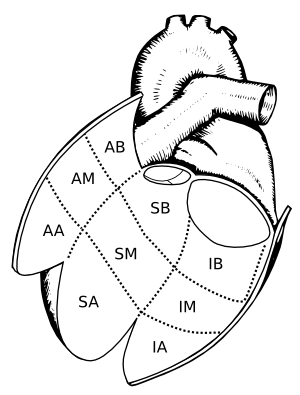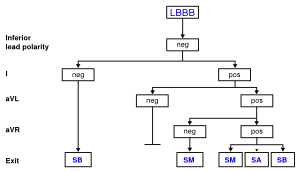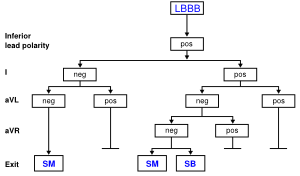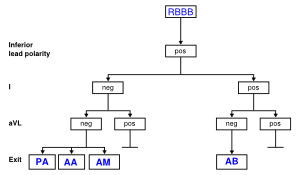Localisation of the origin of a ventricular tachycardia: Difference between revisions
Jump to navigation
Jump to search





mNo edit summary |
mNo edit summary |
||
| Line 1: | Line 1: | ||
[[File:VT_origins.svg|thumb|Areas of the left ventricle where VT's can originate from: The left ventricle is depicted as having been opened. Regions are defined as: '''AA''' = antero-apical; '''AB''' = antero-basal; '''AM''' = mid-anterior; '''SA''' = apical septum; '''SB''' = basal-septum; '''SM''' = mid-septum; '''PA''' = posterior apex; '''PB''' = postero-basal; '''PM''' = mid-posterior | [[File:VT_origins.svg|thumb|Areas of the left ventricle where VT's can originate from: The left ventricle is depicted as having been opened. Regions are defined as: '''AA''' = antero-apical; '''AB''' = antero-basal; '''AM''' = mid-anterior; '''SA''' = apical septum; '''SB''' = basal-septum; '''SM''' = mid-septum; '''PA''' = posterior apex; '''PB''' = postero-basal; '''PM''' = mid-posterior. Adapted from Miller et al.<cite>Miller</cite>]] | ||
The localisation of the origin (or exit site) of a ventricular tachycardia can be helpful in understanding the cause of the VT and is very helpful when planning an ablation procedure to treat a ventricular tachycardia. | The localisation of the origin (or exit site) of a ventricular tachycardia can be helpful in understanding the cause of the VT and is very helpful when planning an ablation procedure to treat a ventricular tachycardia. | ||
Revision as of 17:10, 9 May 2010

Areas of the left ventricle where VT's can originate from: The left ventricle is depicted as having been opened. Regions are defined as: AA = antero-apical; AB = antero-basal; AM = mid-anterior; SA = apical septum; SB = basal-septum; SM = mid-septum; PA = posterior apex; PB = postero-basal; PM = mid-posterior. Adapted from Miller et al.[1]
The localisation of the origin (or exit site) of a ventricular tachycardia can be helpful in understanding the cause of the VT and is very helpful when planning an ablation procedure to treat a ventricular tachycardia.
Using this approach and the algorithms below [2] the exit site can be estimated with reasonable accuracy (PPV around 70%). In these algorhythms, bundle branch block was defined as “left” or “right” based on QRS morphology in lead V1; right bundle branch block (RBBB) pattern was defined by a mono-, bi-, or triphasic R wave or qR in V1; LBBB pattern was defined by a QS, rS, or qrS in V1.

Localising the VT exit in LBBB VT with negative QRS complexes inferior. Adapted from Segal et al.[2]

Localising the VT exit in LBBB VT with positive QRS complexes inferior. Adapted from Segal et al.[2]

Localising the VT exit in RBBB VT with positive QRS complexes inferior. Adapted from Segal et al.[2]

Localising the VT exit in RBBB VT with negative QRS complexes inferior. Adapted from Segal et al.[2]
References
- Miller JM, Marchlinski FE, Buxton AE, and Josephson ME. Relationship between the 12-lead electrocardiogram during ventricular tachycardia and endocardial site of origin in patients with coronary artery disease. Circulation. 1988 Apr;77(4):759-66. DOI:10.1161/01.cir.77.4.759 |
- Segal OR, Chow AW, Wong T, Trevisi N, Lowe MD, Davies DW, Della Bella P, Packer DL, and Peters NS. A novel algorithm for determining endocardial VT exit site from 12-lead surface ECG characteristics in human, infarct-related ventricular tachycardia. J Cardiovasc Electrophysiol. 2007 Feb;18(2):161-8. DOI:10.1111/j.1540-8167.2007.00721.x |